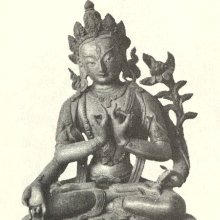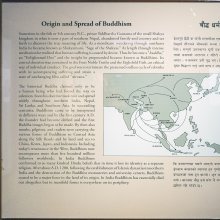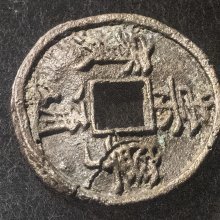Cina, Cīna, Cīnā, Ciṉa, Ciṉā, Cīṉā, Cinā: 25 definitions
Introduction:
Cina means something in Buddhism, Pali, Hinduism, Sanskrit, Jainism, Prakrit, Marathi, Hindi, biology, Tamil. If you want to know the exact meaning, history, etymology or English translation of this term then check out the descriptions on this page. Add your comment or reference to a book if you want to contribute to this summary article.
Alternative spellings of this word include China.
Images (photo gallery)
(+1 more images available)
In Hinduism
Ayurveda (science of life)
Dietetics and Culinary Art (such as household cooking)
Source: Shodhganga: Dietetics and culinary art in ancient and medieval IndiaCīna (चीन) is the name of a region mentioned in a list of regions in the 17th century Bhojanakutūhala (dravyaguṇāguṇa-kathana), and is commonly found in literature dealing with the topics of dietetics and culinary art, also known as Pākaśāstra or Pākakalā.—According to the author people living in different regions [viz., Cīna] have their own nourishing foodstuffs [viz., mārdvīka (grapes)]. Such foodstuffs are more beneficial for them.
Unclassified Ayurveda definitions
Source: Wisdom Library: Āyurveda and botanyCīna (चीन) is a Sanskrit word for a variety of rice (ṣaṣṭika) which is said to have a superior quality, according to Caraka in his Carakasaṃhitā sūtrasthāna (chapter 27), a classical Ayurvedic work. The literal translation of the word is “thread” or “banner”. The plant Cīna is part of the Śūkadhānyavarga group of medicinal plants, referring to the “group of awned grains”. Caraka defined such groups (vargas) based on the dietic value of the plant. Cīna is said to be cold, unctuous, non-heavy, promoting the stability of and alleviates the three doṣas.

Āyurveda (आयुर्वेद, ayurveda) is a branch of Indian science dealing with medicine, herbalism, taxology, anatomy, surgery, alchemy and related topics. Traditional practice of Āyurveda in ancient India dates back to at least the first millenium BC. Literature is commonly written in Sanskrit using various poetic metres.
Purana and Itihasa (epic history)
Source: Cologne Digital Sanskrit Dictionaries: The Purana IndexCīna (चीन).—(c) a northern kingdom;1 unfit for śrāddha;2 people of.3
- 1) Brahmāṇḍa-purāṇa II. 16. 7; 18. 46; 31. 83.
- 2) Matsya-purāṇa 16. 16.
- 3) Vāyu-purāṇa 47. 42; 58. 83.
Cīnā (चीना) is a name mentioned in the Mahābhārata (cf. II.47.19, II.47.22, III.48.21, III.174.12, V.19.15, V.72.14, VI.10.65) and represents one of the many proper names used for people and places. Note: The Mahābhārata (mentioning Cīnā) is a Sanskrit epic poem consisting of 100,000 ślokas (metrical verses) and is over 2000 years old.

The Purana (पुराण, purāṇas) refers to Sanskrit literature preserving ancient India’s vast cultural history, including historical legends, religious ceremonies, various arts and sciences. The eighteen mahapuranas total over 400,000 shlokas (metrical couplets) and date to at least several centuries BCE.
Kavya (poetry)
Source: Wisdom Library: KavyaCīna refers to an ancient district or cultural territory, as mentioned in the 7th-century Mudrārākṣasa written by Viśākhadeva. Cīna probably corresponds to the Chinese.

Kavya (काव्य, kavya) refers to Sanskrit poetry, a popular ancient Indian tradition of literature. There have been many Sanskrit poets over the ages, hailing from ancient India and beyond. This topic includes mahakavya, or ‘epic poetry’ and natya, or ‘dramatic poetry’.
Jyotisha (astronomy and astrology)
Source: Wisdom Library: Brihat Samhita by VarahamihiraCīna (चीन) refers to a country identified with China, belonging to “Aiśānī (north-eastern division)” classified under the constellations of Revatī, Aśvinī and Bharaṇī, according to the system of Kūrmavibhāga, according to the Bṛhatsaṃhitā (chapter 14), an encyclopedic Sanskrit work written by Varāhamihira mainly focusing on the science of ancient Indian astronomy astronomy (Jyotiṣa).—Accordingly, “The countries of the Earth beginning from the centre of Bhāratavarṣa and going round the east, south-east, south, etc., are divided into 9 divisions corresponding to the 27 lunar asterisms at the rate of 3 for each division and beginning from Kṛttikā. The constellations of Revatī, Aśvinī and Bharaṇī represent the north-eastern consisting of [i.e., Cīna] [...]”.

Jyotisha (ज्योतिष, jyotiṣa or jyotish) refers to ‘astronomy’ or “Vedic astrology” and represents the fifth of the six Vedangas (additional sciences to be studied along with the Vedas). Jyotisha concerns itself with the study and prediction of the movements of celestial bodies, in order to calculate the auspicious time for rituals and ceremonies.
General definition (in Hinduism)
Source: archive.org: Indian Historical Quarterly Vol. 7Cīna (चीन) is the name of a country classified as Kādi (a type of Tantrik division), according to the 13th century Sammoha-tantra (fol. 7).—There are ample evidences to prove that the zone of heterodox Tantras went far beyond the natural limits of India. [...] The zones in the Sammoha-tantra [viz., Cīna] are here fixed according to two different Tantrik modes, known as Kādi and Hādi.
In Buddhism
Theravada (major branch of Buddhism)
Source: Pali Kanon: Pali Proper NamesThe Pali name of China. It is several times mentioned in the Milindapanha (121, 327), once as a place where ships congregate (359). Nagasena speaks (121) of a contemporary Cinaraja who could charm the ocean by an Act of Truth and could enter the ocean to a distance of one league in his chariot drawn by lions, the waves rolling back at his approach.
The Apadana (ii.359) speaks of the Cinarattha in a list of countries and tribes.
The Commentaries (E.g., VibbA.159) speak of the softness of Chinese silk (Cinapata).
Theravāda is a major branch of Buddhism having the the Pali canon (tipitaka) as their canonical literature, which includes the vinaya-pitaka (monastic rules), the sutta-pitaka (Buddhist sermons) and the abhidhamma-pitaka (philosophy and psychology).
Mahayana (major branch of Buddhism)
Source: archive.org: Bulletin of the French School of the Far East (volume 5)Cīna (चीन) or Cīnasthāna (in Chinese: Tchen-tan) (identified with China) refers to one of the fifty-five kingdoms enumerated in chapter 17 of the Candragarbha: the 55th section of the Mahāsaṃnipāta-sūtra, a large compilation of Sūtras (texts) in Mahāyāna Buddhism partly available in Sanskrit, Tibetan and Chinese.q

Mahayana (महायान, mahāyāna) is a major branch of Buddhism focusing on the path of a Bodhisattva (spiritual aspirants/ enlightened beings). Extant literature is vast and primarely composed in the Sanskrit language. There are many sūtras of which some of the earliest are the various Prajñāpāramitā sūtras.
In Jainism
General definition (in Jainism)
Source: archive.org: TrisastisalakapurusacaritraCīna (चीन) refers to a sub-division of the Mlecchas: one of the two-fold division of men born in Mānuṣottara and in the Antaradvīpas, situated in the “middle world” (madhyaloka), according to chapter 2.3 [ajitanātha-caritra] of Hemacandra’s 11th century Triṣaṣṭiśalākāpuruṣacaritra: an ancient Sanskrit epic poem narrating the history and legends of sixty-three illustrious persons in Jainism.
Accordingly:—“In these 35 zones on this side of Mānuṣottara and in the Antaradvīpas, men arise by birth; on the mountains, Meru, etc., by kidnapping and power of learning, in the 2½ continents and in 2 oceans. [...]. From the division into Āryas and Mlecchas they are two-fold. [...] The Mlecchas—[e.g., the Cīnas, ...] and other non-Āryas also are people who do not know even the word ‘dharma’”.

Jainism is an Indian religion of Dharma whose doctrine revolves around harmlessness (ahimsa) towards every living being. The two major branches (Digambara and Svetambara) of Jainism stimulate self-control (or, shramana, ‘self-reliance’) and spiritual development through a path of peace for the soul to progess to the ultimate goal.
Biology (plants and animals)
Source: Google Books: CRC World Dictionary (Regional names)1) Cina in India is the name of a plant defined with Acalypha hispida in various botanical sources. This page contains potential references in Ayurveda, modern medicine, and other folk traditions or local practices It has the synonym Ricinocarpus hispidus (Burm. f.) Kuntze (among others).
2) Cina is also identified with Aristolochia bracteata.
3) Cina is also identified with Artemisia maritima It has the synonym Seriphidium maritimum (L.) Poljakov (etc.).
4) Cina is also identified with Cissampelos pareira It has the synonym Chondodendron tomentocarpum (Rusby) Moldenke (etc.).
5) Cina is also identified with Oryza sativa It has the synonym Oryza sativa var. suberythroceros Kanevsk (etc.).
Example references for further research on medicinal uses or toxicity (see latin names for full list):
· Hortus Bengalensis, or ‘a Catalogue of the Plants Growing in the Hounourable East India Company's Botanical Garden at Calcutta’ (1814)
· Taxon (1980)
· Proceedings of the Indian Science Congress Association (1987)
· Blumea, Supplement (1946)
· J. SouthW. Agric. Univ. (1994)
· Nova Genera et Species Plantarum (1821)
If you are looking for specific details regarding Cina, for example extract dosage, chemical composition, pregnancy safety, diet and recipes, health benefits, side effects, have a look at these references.

This sections includes definitions from the five kingdoms of living things: Animals, Plants, Fungi, Protists and Monera. It will include both the official binomial nomenclature (scientific names usually in Latin) as well as regional spellings and variants.
Languages of India and abroad
Marathi-English dictionary
Source: DDSA: The Molesworth Marathi and English Dictionarycīṇa (चीण).—f ( P) The ruffle or plaits of a garment. 2 A crack or an opening (as in a wall or floor). 3 C (ciṇaṇēṃ) A well-beaten terrace or floor.
--- OR ---
cīna (चीन).—m n The root of cinī (a variety of yam). 2 m f ( P) The ruffle or plaits of a garment. 3 f (Better cīṇa) A crack or fissure. 4 n or cīna- rēśīma n An inferior kind of silk.
Source: DDSA: The Aryabhusan school dictionary, Marathi-Englishcīṇa (चीण).—f The ruffle of a garment. A crack. A well-beaten floor.
Marathi is an Indo-European language having over 70 million native speakers people in (predominantly) Maharashtra India. Marathi, like many other Indo-Aryan languages, evolved from early forms of Prakrit, which itself is a subset of Sanskrit, one of the most ancient languages of the world.
Sanskrit dictionary
Source: DDSA: The practical Sanskrit-English dictionaryCīna (चीन).—[ci-nak pṛṣo ° dīrghaḥ]
1) Name of a country, the modern China.
2) A kind of deer.
3) A sort of cloth.
4) A thread.
-nāḥ m. (pl.) The rulers or people of China.
-nam 1 A banner.
2) A kind of bandage for the corners of the eyes.
3) Lead.
Derivable forms: cīnaḥ (चीनः).
Source: Cologne Digital Sanskrit Dictionaries: Shabda-Sagara Sanskrit-English DictionaryCīna (चीन).—m.
(-naḥ) 1. A kind of deer. 2. A sort of panic, (Panicum miliaceum.) 3. A country, China. 4. A sort of cloth 5. A thread. n.
(-naṃ) 1. A banner, (perhaps made of deer skin.) 2. Lead. E. ci to collect, nak affix, and the deriv. irr. pṛṣo dīrghaḥ .
Source: Cologne Digital Sanskrit Dictionaries: Benfey Sanskrit-English DictionaryCīna (चीन).—m. 1. pl. The name of a people, [Mānavadharmaśāstra] 10, 44. 2. A sort of cloth, [Suśruta] 1, 65, 14.
Source: Cologne Digital Sanskrit Dictionaries: Cappeller Sanskrit-English DictionaryCīna (चीन).—[masculine] [plural] the Chinese.
Source: Cologne Digital Sanskrit Dictionaries: Monier-Williams Sanskrit-English Dictionary1) Cīṇa (चीण):—for cīna etc. q.v.
2) Cīna (चीन):—m. [plural] the Chinese, [Manu-smṛti x, 44; Mahābhārata ii f., vf.; Rāmāyaṇa iv, 44, 14; Lalita-vistara; Jaina literature; Caraka; Varāha-mihira’s Bṛhat-saṃhitā] (also cīṇa)
3) m. sg. a kind of deer, [cf. Lexicographers, esp. such as amarasiṃha, halāyudha, hemacandra, etc.]
4) Panicum miliaceum (also cinna, [cf. Lexicographers, esp. such as amarasiṃha, halāyudha, hemacandra, etc.])
5) a thread, [cf. Lexicographers, esp. such as amarasiṃha, halāyudha, hemacandra, etc.]
6) n. a banner, [cf. Lexicographers, esp. such as amarasiṃha, halāyudha, hemacandra, etc.]
7) a bandage for the corners of the eyes, [Suśruta i, 18, 11]
8) lead, [cf. Lexicographers, esp. such as amarasiṃha, halāyudha, hemacandra, etc.]
Source: Cologne Digital Sanskrit Dictionaries: Yates Sanskrit-English DictionaryCīna (चीन):—(naḥ) 1. m. A kind of deer; of panic; of cloth; thread; China. n. A banner; tin.
Source: DDSA: Paia-sadda-mahannavo; a comprehensive Prakrit Hindi dictionary (S)Cīna (चीन) in the Sanskrit language is related to the Prakrit word: Cīṇa.
[Sanskrit to German]
Sanskrit, also spelled संस्कृतम् (saṃskṛtam), is an ancient language of India commonly seen as the grandmother of the Indo-European language family (even English!). Closely allied with Prakrit and Pali, Sanskrit is more exhaustive in both grammar and terms and has the most extensive collection of literature in the world, greatly surpassing its sister-languages Greek and Latin.
Hindi dictionary
Source: DDSA: A practical Hindi-English dictionaryCīnā (चीना):—(nm) millet; a Chinese; (a) belonging to China.
...
Prakrit-English dictionary
Source: DDSA: Paia-sadda-mahannavo; a comprehensive Prakrit Hindi dictionaryCīṇa (चीण) in the Prakrit language is related to the Sanskrit word: Cīna.
Prakrit is an ancient language closely associated with both Pali and Sanskrit. Jain literature is often composed in this language or sub-dialects, such as the Agamas and their commentaries which are written in Ardhamagadhi and Maharashtri Prakrit. The earliest extant texts can be dated to as early as the 4th century BCE although core portions might be older.
Kannada-English dictionary
Source: Alar: Kannada-English corpusCina (ಚಿನ):—[adjective] = ಚಿನ್ನ [cinna]2.
--- OR ---
Cina (ಚಿನ):—[noun] = ಚಿನ್ನ [cinna]3.
--- OR ---
Cīṇa (ಚೀಣ):—[noun] = ಚೀನ [cina]1.
--- OR ---
Cīna (ಚೀನ):—
1) [noun] the name of a country to the north of India; China.
2) [noun] a kind of silk cloth, formerly produced in China.
3) [noun] a kind of deer.
--- OR ---
Cīna (ಚೀನ):—[noun] a kind of percussion instrument used to make a loud sound in battlefield.
Kannada is a Dravidian language (as opposed to the Indo-European language family) mainly spoken in the southwestern region of India.
See also (Relevant definitions)
Starts with (+122): Cina cina, Cina-erivantu, Cina-kkanakam, Cina-kkanakkam, Cina-pagoda, Cina-tungabhadra, Cinabilimara, Cinabommabhupala, Cinacappattucceti, Cinacara, Cinacaraprayogavidhi, Cinacarasaratantra, Cinaccamanti, Cinaccarappali, Cinaccurul, Cinaccutan, Cinacela, Cinacika, Cinacina, Cinadaru.
Ends with (+64): Acina, Adharacina, Aganosma calycina, Alloteropsis cimicina, Ampelocissus bombycina, Anucina, Apacina, Aparacina, Apracina, Aracina, Artemisia cina, Arvacina, Arvvacina, Asamicina, Asystasia calycina, Atipracina, Atirashcina, Avacina, Baru cina, Bauhinia calycina.
Full-text (+101): Cinamshuka, Cinaja, Aparacina, Cinavanga, Cinakarpura, Cinapatta, Cinakarkatika, Cinaka, Cinapishta, Ciṇṇa, Cinarajaputra, Dhautamulaka, Cinakarkati, Cirnakarkati, Kirata, Cina cina, Patikan cina, Vicitracinamshuka, Kembang suri cina, Kedondong cina.
Relevant text
Search found 22 books and stories containing Cina, Cīna, Cīṇa, Cīnā, Ciṉa, Ciṉā, Cīṉā, Cinā; (plurals include: Cinas, Cīnas, Cīṇas, Cīnās, Ciṉas, Ciṉās, Cīṉās, Cinās). You can also click to the full overview containing English textual excerpts. Below are direct links for the most relevant articles:
Trishashti Shalaka Purusha Caritra (by Helen M. Johnson)
Part 30: Mlecchas < [Chapter III - The initiation and omniscience of Ajita]
Chaitanya Bhagavata (by Bhumipati Dāsa)
Verse 1.11.37 < [Chapter 11 - Meeting with Śrī Īśvara Purī]
Verse 1.11.46 < [Chapter 11 - Meeting with Śrī Īśvara Purī]
Verse 1.1.39 < [Chapter 1 - Summary of Lord Gaura’s Pastimes]
Cosmetics, Costumes and Ornaments in Ancient India (by Remadevi. O.)
7. Trade and Commerce (of clothes and dresses) < [Chapter 2 - Costumes]
2.1. Upper Garments (g): Colaka (stitched dress) < [Chapter 2 - Costumes]
Manusmriti with the Commentary of Medhatithi (by Ganganatha Jha)
Verse 10.44 < [Section III - Status of the Mixed Castes]
List of Mahabharata people and places (by Laxman Burdak)
List of Mahabharata tribes (by Laxman Burdak)





